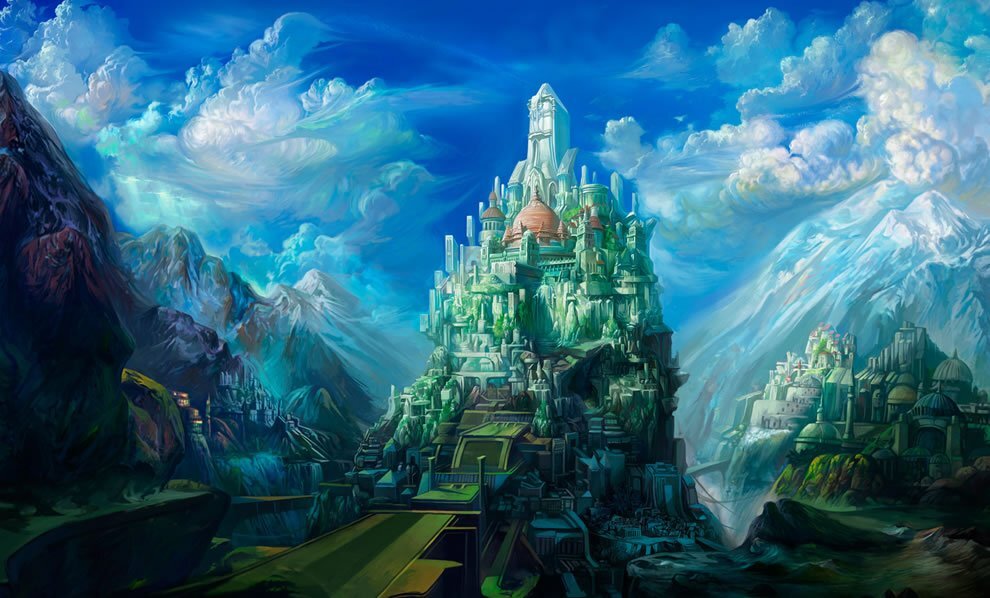The Basics of World Building: Realism, Believability & Fantasy
Let’s talk about realism in our fantasy TTRPG games.
Now, generally, I hate using the word realism when I’m talking about creating fantasy worlds, because people really misinterpret what makes a world palpable for the average player. It’s often used as a justification for very not-fun elements to be implemented in a world, or attempting to force a concept that wouldn’t reasonably exist based on how the world has been set up. You’ve probably heard someone say ‘it’s only realistic for x to act in x way’, but that is often said in regards to how said thing would occur in the ‘real world’ as opposed to a fantasy world.
Before we dig into this, let me explain how I’m using each one of these words:
Realism. How something would occur in a fantasy world in relation to how it occurs in the ‘real world’ (i.e. when you are a strong person, it is realistic that you would be able to shove people smaller than you to the ground with ease.)
Fantasy. The opposite of realism - they are things that have zero comparison in the real world and thus can operate on their own threads of logic (i.e. magic cannot be compared to anything in the real world, in most cases, because magic doesn’t exist.)
Believability. The degree at which you can extend your disbelief while immersed in a world (i.e. magic does not exist in the real world, but you are perfectly capable of acknowledging and believing it could exist in a fantasy world.)
As readers and viewers of fantasy, we have different thresholds for how much we’re willing to believe based on what information we have on the world and how it functions. If the world is set up well, people will rarely question how something is possible, because the world does a good job establishing that it is possible. A misconception is that you need a broken down, fundamental, near scientific explanation for everything that occurs in your world, but that simply is not true. At the same time, you need some rules in your world. If there are zero rules, then you can easily overextend someone’s disbelief, disconnecting them from the world they’re in. The key is a balance between the two.
Realism Does Not Automatically Make a World Believable
Notice how I’m noting the difference between realism and believability. While they are often considered synonymous, they are very different things. Realism is often used as a means to help establish something’s credibility, because there is a direct comparison to something we are already familiar with in the real world. In a vacuum or with specific scenarios, it can be a good way to weed out questions regarding something that can or can’t reasonably happen in both the ‘real world’ and a fantasy world. For example: the laws of physics in the real world are often also applied in a fantasy world i.e. if you throw a javelin at a target, you do not have to explain that the javelin would fly in a straight line, losing altitude until it hits the target or the ground. Another example: a humanoid cannot walk through walls or see through them. You do not have to reestablish that people can’t walk through walls, because people will think in the real world, I can’t walk through walls, so I can’t walk through walls in this world.
However: realism is often a very poor way to explain why something happens the way it does in what is established as a fantasy world. Other than the absolute basics - like the laws of physics, gravity, etc. - you cannot reasonably compare something that occurs in fantasy to something that happens in the real world. As a result, making something ‘realistic’ can often have the unintended consequence of making your world less believable.
Furthermore, it must be understood that a TTRPG is, above all else, a game. It has mechanics that inherently go beyond the realms of realism, but not the realms of believability. By all rights and accounts, the player characters in a D&D game, even ones that don’t use outright fantasy things like magic, are constantly taking actions that wouldn’t make sense in the real world. However, it is believable to someone playing the game that they can do those things, because the suspension of disbelief is much higher for someone playing a game with mechanics that explain that you are able to do something.
Let’s look at another example: let’s say you have firearms in your D&D world. Now, realistically, medieval armor like leather and plate would stand zero chance against a bullet. It would go straight through it. So, that means you should mechanically make it where guns ignore all armor a creature is wearing, yes? Well, no, because not only would that make firearms entirely unbalanced in game, but also assumes that medieval armor and guns, respectively, are exactly the same as they are in real life. You create a question of why are people still using swords and crossbows when guns ignore all armor?
If you go down the rabbit hole of picking apart every inaccuracy with real life, you’ll end up contradicting yourself and making a lot more work. You’d have to reestablish and explain a lot of the mechanics of certain classes in order to be consistent with that logic and, in most cases, that results in having unnecessary weaknesses for players. You simply cannot accept that magic and dragons are real, but then turn around start questioning how a fighter can take three attacks in six seconds. Some things can be left unsaid without compromising tone and theme and setting.
Save for the most scrutinizing player, a suspension of disbelief is going to be much greater in a D&D game. Sure, it isn’t realistic that a long rest (sleeping for eight hours) in D&D would heal all your injuries, regardless of severity, but someone playing the game is rarely going to complain about such a mechanic existing. Occasional reminders that the players are, indeed, playing a game are not going to break immersion if the rest of the world is established well.
Realism, unfortunately, is also often used as an excuse to implement something in the game that makes your players uncomfortable. D&D is meant to be fun, and no amount of ‘this happened in the middle ages in real life’ excuses are good enough to justify making anyone at the table uncomfortable or uneasy. Saying something is realistic does not negate all criticism of an aspect of the world. Remember to always clear potentially uncomfortable themes with your players before using them in game.
You Decide What is Real
Trying to compare everything to real life will hinder your creativity and end up making way more work than if you just use the mechanics of D&D that you are given and work around them. You are the weaver of this world, and it is you who decides if something is or isn’t possible. This is the beauty of making everything your own: if you do want the average person to be capable of walking through walls, you can absolutely do that. However: in many cases, you should have an answer for the question of why.
Even fantasy worlds have some rules. Believability operates on the logic that there is a method to the madness - that method just doesn’t have to be a real world comparison. Having a grounding set of rules for your world is extremely important for establishing immersion while also explaining why things are the way they are and why they can’t be solved easily. If there are no rules, and people can just do whatever they want, you create a disconnect between the player and the world that prevents them from taking it seriously.
This likely sounds like a massive wet blanket for particularly ridiculous, hair-brained schemes you see put together by D&D players, but it really isn’t. If you create a flexible world, it means players can pull off incredible feats, but can’t do the impossible. And, once again, you decide what is possible.
The existence of the actual game part of TTRPGs presents an element to world building other mediums of narrative design don’t have, save for one: video games. While there’s still differences, good video games tend to have the mechanics of the game coincide with the world they build. Legend of Zelda: Breath of the Wild presents a huge, open world that is very navigable by Link’s skills, and everything in the environment can be traversed because of it. You should keep the same thing in mind when you write for D&D 5e games - consider the abilities the players have or eventually will have and how they can be used in the world around them. Not only does it create a sense of accomplishment and belonging in the world, but it also allows you to invisibly convey what is and isn’t possible.
The Rules You Have Should Make Sense
There is a misconception I often see where having rules makes a game less fun, which, in my opinion, is not the case. If the rules are loose enough to allow for some shenanigans, but tight enough to keep the world consistent, it will increase the believability of the world and make it more engaging.
The existing rules for D&D 5e games can also make great prompts for personal lore. For example: rules as written, all resurrection spells (save for Reincarnate) require the use of diamonds of various worth, based on the power of the spell. For my world, I added lore on why this is the case: that diamonds are actually pieces of stars, and because all mortal creatures are created from the stars, the diamonds can be used to return them to life. That’s the skinny version, but ultimately, adding lore to the rules makes them much more fun to implement and be able to do so smoothly in the game.
Of course, other things in your world you don’t always have to instantly explain. You may get a particularly curious (or needling) player who wants you to break down the reason why certain things are and aren’t possible, or why x is needed for x. Some of these questions can be answered through in-game discovery, which should be a fun way to engage the player. Other times, you can outright explain it, or direct your players to read lore you’ve written out. Ultimately, however, you don’t have to explain. As the DM, if you want all the elephants in your world to be purple, you can just do that without explanation. For fairly mundane, cosmetic changes, you don’t need a reason.
That being said, it’s a good idea to have some explanations if you’re going to drastically change how something generally works in D&D mechanically. Remember, you always have to keep in mind that you are working with rules, and some people in your game may be familiar with those rules and not familiar with what you’re changing them to. If you decide to completely remove resurrection spells from your game, for example, having an in-world reason can make it easier to accept those changes. If the reason is just ‘I don’t want this in the game because I don’t want to deal with it’, that’s fine too, as long as that is established for the player.
Keeping the balance of your personal preference, the preference of your players, and the objective need to maintain consistent rules in your campaign can be very difficult. The best way to mediate it is to communicate clearly with your players, compromise with them if they have reasonable requests, and eventually curate a group that likes your ideas as much as you do. I’ll talk further about player/DM dynamics in another article, but for now, I recommend you always give your players the chance to add something to your world. You’ll never know how much they can contribute until you allow them to do so.







